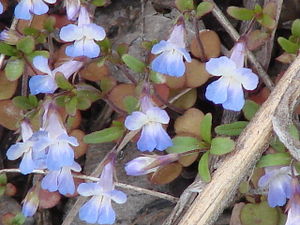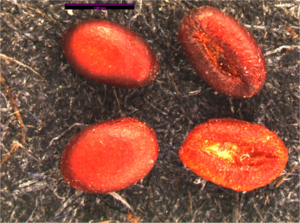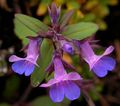Difference between revisions of "Collinsia parviflora"
(→Description) (Tag: VisualEditor) |
(→Description) (Tag: VisualEditor) |
||
| Line 30: | Line 30: | ||
===Description=== | ===Description=== | ||
| − | Annual herb | + | Annual, erect herb with small axillary blue to pinkish flowers, up to 40 cm tall.<ref name=":0" /> Stem simple to branched, sparsely pubescent.<ref name=":0" /> Leaves opposite; lower leaves long-petiolate, orbicular to rotund; upper leaves oblong to linear-lanceolate, to 4 cm long.<ref>Bowcutt, F., & Hamman, S. (2016). ''Vascular Plants of the South Sound Prairies''. p. 109.</ref> Flowers zygomorphic, pedicelate 4-7 mm long;<ref name=":0" /> calyx 5-lobed, subequal; corolla bilabiate, tube not bent at right angle to calyx, 2 upper lobes, 3 lower lobes; stamens 4, didynamous; stigma capitate,<ref>Hitchcock, C. L., Cronquist, A., Giblin, D., |
| − | + | & Legler, B. et al. (2018). ''Flora of the Pacific Northwest: an | |
| − | + | illustrated manual''. Seattle: University of Washington Press. p. 455.</ref> ovary 2-carpellate, superior,<ref>Hitchcock, C. L., Cronquist, A., Giblin, D., | |
| − | + | & Legler, B. et al. (2018). ''Flora of the Pacific Northwest: an | |
| − | + | illustrated manual''. Seattle: University of Washington Press. p. 452.</ref> becoming an elliptical capsule.<ref name=":0" /> | |
===Bloom Period=== | ===Bloom Period=== | ||
| − | March - July<ref>WTU Herbarium, Burke Museum, & University of Washington. Retrieved from http://biology.burke.washington.edu/herbarium/imagecollection/taxon.php?Taxon=Collinsia%20parviflora</ref> | + | March - July<ref name=":0">WTU Herbarium, Burke Museum, & University of Washington. Retrieved from http://biology.burke.washington.edu/herbarium/imagecollection/taxon.php?Taxon=Collinsia%20parviflora</ref> |
===Distribution=== | ===Distribution=== | ||
Revision as of 13:54, 28 June 2021
- Scientific Name: Collinsia parviflora
- Family: Plantaginaceae
- Common Names: small-flowered blue-eyed Mary, collinsia
- Synonyms/Misapplications: Collinsia grandiflora
- Codon: COLPAR
Contents
Taxonomy
| Scientific classification | |
|---|---|
| Kingdom: | Plantae |
| Subkingdom: | Viridiplantae |
| Phylum: | Tracheophyta |
| Subphylum: | Spermatophytina |
| Class: | Magnoliopsida |
| Subclass: | Asteranae |
| Order: | Lamiales |
| Family: | Plantaginaceae |
| Genus: | Collinsia Nutt. |
| Species: | Collinsia parviflora Lindl. |
| Synonyms | |
| |
Description
Annual, erect herb with small axillary blue to pinkish flowers, up to 40 cm tall.[2] Stem simple to branched, sparsely pubescent.[2] Leaves opposite; lower leaves long-petiolate, orbicular to rotund; upper leaves oblong to linear-lanceolate, to 4 cm long.[3] Flowers zygomorphic, pedicelate 4-7 mm long;[2] calyx 5-lobed, subequal; corolla bilabiate, tube not bent at right angle to calyx, 2 upper lobes, 3 lower lobes; stamens 4, didynamous; stigma capitate,[4] ovary 2-carpellate, superior,[5] becoming an elliptical capsule.[2]
Bloom Period
March - July[2]
Distribution
Occurs in BC extending south to California and east to Manitoba, Michigan, Colorado and Arizona (Pojar and MacKinnon, 1994; Ganders and Krause, 1986; Elle, 2002).
Habitat
Rocky outcrops in coastal Douglas-fir zone. Areas that dry out rapidly in summer. Low to middle elevations but occasionally higher. Absent from the wet outer coast.
Seed
Abbreviation: COPA
Seed sample from: 2011
Average measurement: 0.7 x 1.5 x 1
Measurement range: L: 0.5 - 0.9, W: 1.3 x 1.7, D: 0.9 x 1.3
Features
Color Seeds bright red with elliptical, white, large depression that is the hilium on a longer seed side.
Surface Seeds red, matte, and very slightly bumpy. Possibly smoother than COGR. Some seeds have seed coat ridges at the edge of the seed, giving it a somewhat winged look.
Seed slightly larger than Collinsia grandiflora.
Could be confused with: Collinsia grandiflora.
Latitudinal cross section: elliptical ![]()
Longitudinal cross section: irregular
Basic Explanations and Assumptions:
The dimensions for the seeds are length x width x depth. The location of the hilum is used as the base of the seed, and the length is measured from hilum to the opposite apex. Where a style is present, the length is measured from the hilum to the bottom of the style. Width is measured at a right angle to the length at the widest part. Depth is measured at a right angle to the intersection of height and width lines.
Measurements included are the mean average for each measurement of ten separate seeds.
All measurements in millimeters unless otherwise noted.
Photo Gallery
References
- ↑ Integrated Taxonomic Information System. Retrieved from https://www.itis.gov/servlet/SingleRpt/SingleRpt?search_topic=TSN&search_value=33534
- ↑ 2.0 2.1 2.2 2.3 2.4 WTU Herbarium, Burke Museum, & University of Washington. Retrieved from http://biology.burke.washington.edu/herbarium/imagecollection/taxon.php?Taxon=Collinsia%20parviflora
- ↑ Bowcutt, F., & Hamman, S. (2016). Vascular Plants of the South Sound Prairies. p. 109.
- ↑ Hitchcock, C. L., Cronquist, A., Giblin, D., & Legler, B. et al. (2018). Flora of the Pacific Northwest: an illustrated manual. Seattle: University of Washington Press. p. 455.
- ↑ Hitchcock, C. L., Cronquist, A., Giblin, D., & Legler, B. et al. (2018). Flora of the Pacific Northwest: an illustrated manual. Seattle: University of Washington Press. p. 452.






